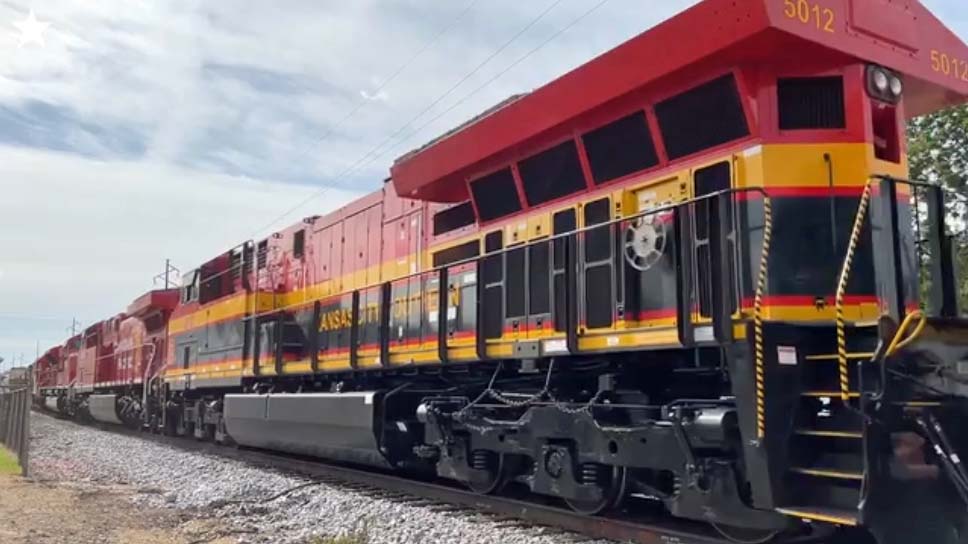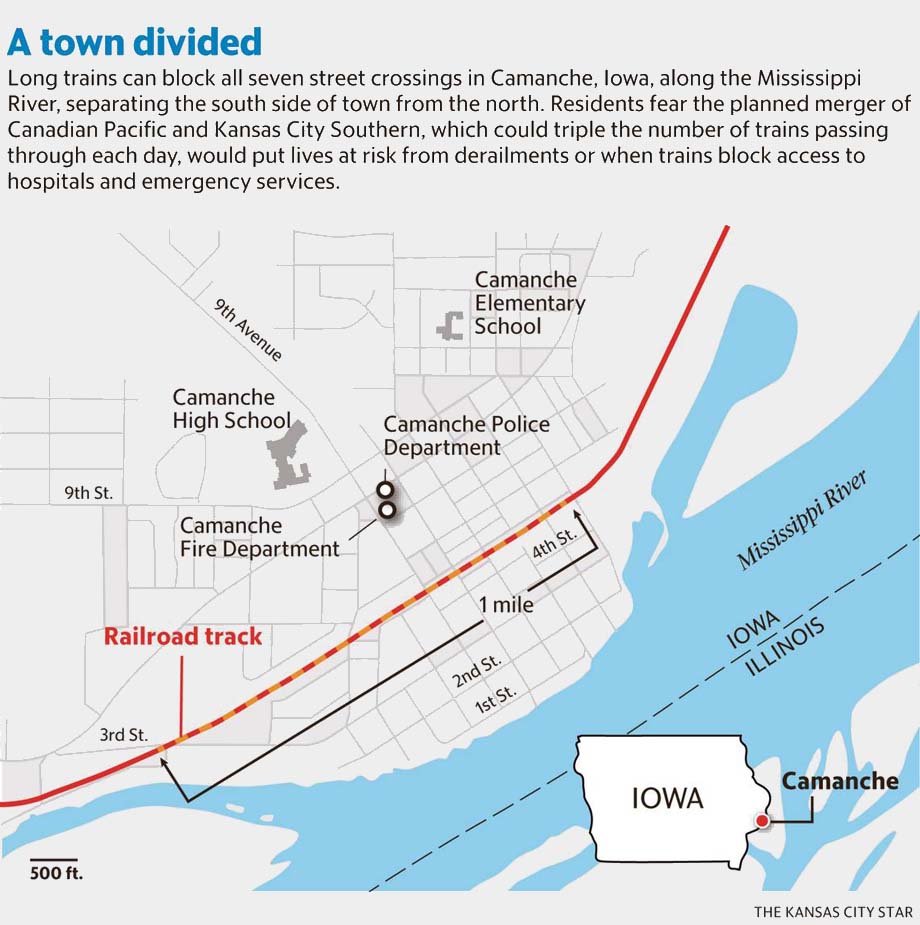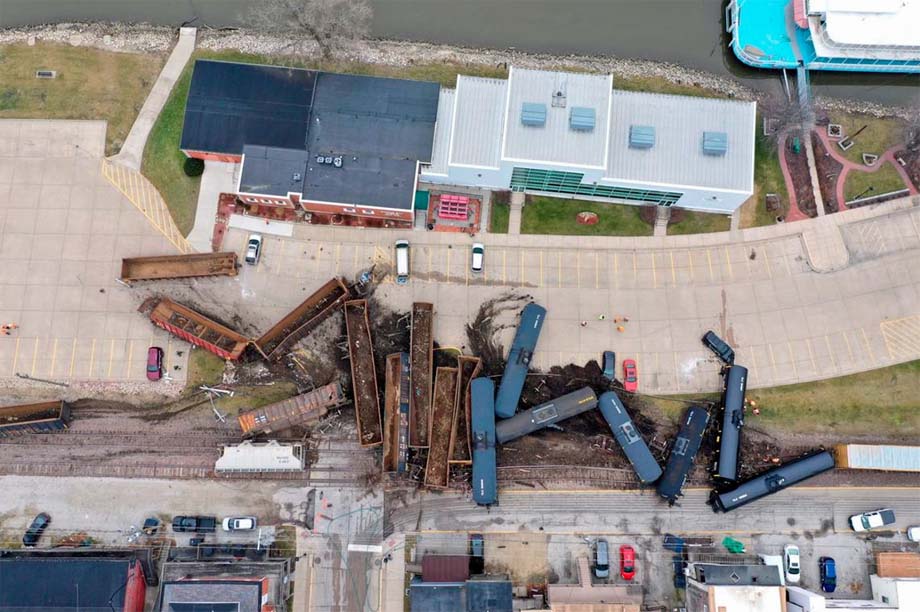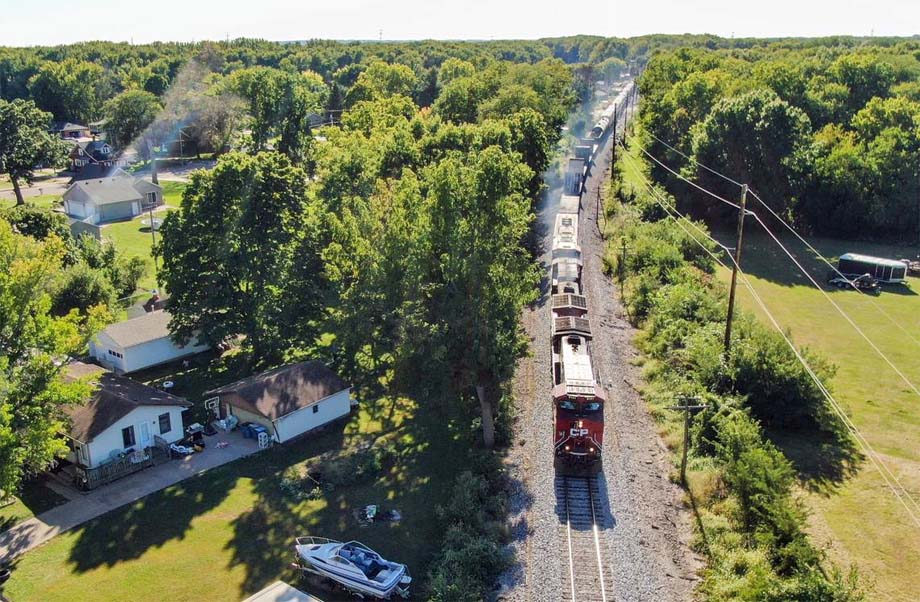
Camanche Iowa USA - In this small town on the upper Mississippi River, where railroad tracks slice
the length of the community, and freight horns seem as common as bird song, residents fear that life is about to get
more dangerous.
David Maze, who has lived happily and safely in Camanche since birth, is worried that the trains that roll not far from
his clapboard house could one day kill him, maybe his neighbors, and cause his town of 4,300 residents to
suffer.
His concern is the concern of many here, if a proposed US$31 billion merger between two powerful rail companies, Kansas
City Southern and Canadian Pacific Railway, receives federal approval in early 2023, the number of so-called
"monster" freight trains rumbling through the town each day will triple.
Instead of five to 10 trains per day, the merger is expected to bring an average of 21, perhaps more, many of them
heavier and at massive lengths.
Camanche is not alone.
Cities and small towns stretching from Houston to Chicago are similarly afraid of how a merger will affect daily
life.
But the fight, and its possible consequences, is perhaps sharpest here, where the town along the tracks is only a mile
long and train lengths are expected to grow to two, even three miles long.
What if Maze, who has epilepsy, has a grand mal seizure, or someone has a heart attack, or stroke, or is hurt and
bleeding from an accident?
What if there is a derailment, a spill of oil or toxic chemicals, that could leave some residents trapped between the
tracks and the Mississippi River?

Problem is the police are on the north side of the tracks.
So is the main firehouse.
Schools, hospitals, and ambulances also are on that side, with no bridges or tunnels for access.
When the trains block crossings, sometimes for up to two hours, a quarter of the town is left vulnerable.
"To go from here to any hospital by way of ambulance simply can't be done because of the trains going
through," said Maze, 74.
"To say that would be a danger would be an understatement."
For Canadian Pacific and Kansas City Southern, the benefits of a merger are straight forward.
The merger would join 7,300 miles of KCS tracks with 15,000 miles of CP's to create a single north-south rail corridor
that would bisect the center of the country, stretching 22,000 miles from deep into Mexico to Canada.
CP, in an email to The Star, said it sees the merger as "a once-in-a-lifetime combination" that will increase
rail competition, open new markets to shippers, and create 1,000 new jobs systemwide, including the transfer of 200
jobs to Kansas City when CP relocates its U.S. headquarters from Minneapolis.
The railroad further asserts that the merger will help the environment by taking as many as 60,000 trucks off the roads
each year.
In terms of potential harm, it cites the draft summary from the federal government's own Surface Transportation Board
(STB) environmental impact analysis that in August concluded, "apart from train noise, which could result in
adverse impacts at some locations, the potential adverse impacts of the Proposed Acquisition would be negligible,
minor, and/or temporary."
Comanche sees itself in a fight that, while perhaps unwinnable, remains righteous.
Rural town against major railroads.
Powerless homeowners against a powerful industry.
Tiny town and Main Street versus Wall Street, and monied corporate interests who, as Camanche residents see it, likely
see a tiny hamlet in upper Iowa as little more than a pesky inconvenience.
In August, some 80 residents packed a Camanche City Council hearing on the merger.
More than a dozen people spoke up to decry it.
No one spoke for it.
Dave Schutte, the city's fire chief for 16 years, urged city leaders to fight approval by the STB.
"Nothing scares me more than the fact that the trains are going to be twice as long and three times as
frequent," Schutte said.
"I worry about those over 400 residences on the other side of the tracks."
Paul Varner, a city council member and mayor pro-tem, is a retired EMT and firefighter.
He stood by the tracks recently, where that morning, a two-mile long train pulling tank cars rumbled by.
"We're certainly not opposed to CP making a profit," he said.
But any guarantees the railroad provides that crossings won't regularly be blocked simply can't be trusted, he
said.
"Being a firefighter and an EMT, I've had all seven of these crossings blocked, we're doing CPR on a guy in the
back of the ambulance, and we can't get across the tracks to get him to the hospital," Varner said.
"So that does happen. Whether they claim it does or not is beside the point. It's happened because I've
experienced it."
Why the Merger
After decades of railroad consolidation, the proposed linking of CPKC, a force in Kansas City with an ancestry dating
to 1887, is being viewed as what is likely the last major merger to occur among the seven Class 1 or major freight
lines that run through the United States.
KCS is the smallest of all the big railroads.
Should the STB, the economic regulator of American railroads approve the merger, the U.S. would be left with six major
carriers, Union Pacific and BNSF in the West, CSX and Norfolk Southern in the East, Canadian National and the the newly
named merged company, CPKC running north and south.
The benefits to the merged railroad are obvious, more profits, more customers, a bigger corporate footprint, and more
freight over what will be 22,000 miles of combined track.
Under a new name, CPKC would be the first and only railroad to run a direct line between Canada and Mexico, bisecting
and hauling freight through the heart of the country, including Kansas City, the second largest freight rail center in
the United States.
Last year, CP Chief Executive Officer Keith Creel told The Star that the merger would mean more jobs and greater job
security for KCS employees.
"You're going to see a city that forever will be an integral piece of this network," he said.
But while a merger is likely to be a boon to the combined railroads, countless critics, ranging from tiny towns like
Camanche, to powerful politicians, to other railroads, insist that the corporate coupling will deliver
troubles.
The list is long, including the near doubling to quadrupling of heavy rail traffic through more than 230 communities in
eight states that include Texas, Oklahoma, Louisiana, Arkansas, Iowa, Illinois, Missouri, and Kansas.
Some towns, like Pittsburg, Kansas, which possesses a terminal for KCS, are excited about more traffic and the
potential for added jobs.
"We love trains," Pittsburg City Manager Daron Hall said.
"We love train traffic. We'll be OK."
Resident Concerns
But, critics say, more and longer trains mean blocked crossings, relentless noise, plummeting property values, and
greater odds of cataclysmic derailment, such as tank cars spilling oil and hazardous chemicals.
"If this merger goes through, you're talking about more trains," Robert Gellegos, city council member in
Houston, Texas, told local media this year.
"Year to date, we have over 900 cases where EMS vehicles could not get through because of stalled
trains."
In the Chicago area, political leaders worry that the merger would run so much more freight, it could prompt hundreds
of thousands of passengers to forgo using Metra, the commuter rail line that feeds the suburban Chicago
area.
Traffic on one major route is controlled by CP, even though the line is owned by Metra.
The concern is that more freight will mean more commuter delays.
"If the merger goes through as proposed, it will break the railroad system," Evan Summers, the village
manager of Bensenville, west of Chicago, told local media.
While CP asserts that the merger will help the environment by taking thousands of trucks off the roads each year, Rep.
Raja Krishnamoorthi, who represents Chicago's northwest suburbs in Congress, suggests the environmental impact could be
worse, not because of trucks, but because of cars.
"In reality, this merger as proposed would cause potentially hundreds of thousands of commuters to drive rather
than take Metra trains," he told the STB, "thus clogging our roads, harming the environment, and setting back
public transit for decades."
In July, Illinois' two U.S. senators, Dick Durbin and Tammy Duckworth, together with two state lawmakers, voiced their
opposition to the STB, noting that rail traffic between the cities of Bensenville and Elgin, Illinois, was projected to
more than triple.
"We are concerned this increase will have significant impacts on noise, emergency response, commuter rail
operations, the environment, and pedestrian safety," the lawmakers warned.
In Excelsior Springs north of Kansas City, 30 residents in September turned out for a public hearing on the merger held
by board officials.
Excelsior Springs sees an average of about four trains per day.
Under the merger, their number would jump to an average of 18.
A dozen or so STB staffers were there, headed by the board's chairman, Martin J. Oberman. Joshua Wayland, the board's
acting deputy director in the office of environmental analysis, explained why the railroads were merging, according to
their application.
Yes, the merger would mean more trains, more delays at crossings, but the railroads maintain, again, that it would
remove trucks.
The residents who spoke were having none of it.
Taking thousands of trucks off the roads sounds good, resident Doug Hauser said.
But that number is spread across highways spanning the country.
Excelsior Springs, meanwhile, would still get 500 percent more train traffic.
"We are going to be exposed to 500 percent more noise," he said, "500 percent more air pollution from
these trains, 500 percent greater increase in collisions, a 500 percent increase in traffic delays, and on and on and
on."
Camanche's Fight
The residents and leaders of Camanche feel the same.
It's the vocal David-versus-Goliath opposition from this tiny town that has captured national attention.
Isn't it time, they argue, that someone cared about the people who live along the tracks?
"What do we do if we need emergency care?" asked Kitt Swanson, standing with her husband, Keith, in the
driveway of their Camanche home, set yards away from the 13th Avenue crossing.
Swanson suffers diabetes and worries about people, like her, being put at risk.
"That's not right," she said, "not to the citizens on this side."
Located on the eastern edge of Iowa, with Illinois across the water, Camanche is an old town, with its roots planted
in 1836, some 20 years before the Burlington Cedar Rapids & Northern Railway laid the town's first set of tracks in
1857.
Though named for the Native American Comanche tribe, the town is pronounced "Camanch," with no long
"e."
It's picturesque, a place of well-kept homes along a water front used more for recreation than commerce.
Backyard lawns, docks, and boat ramps slope to the Mississippi's edge.
On a fall morning, herons were feeding there.
Residents speak proudly of the town's history as a place for river trade, where clam shells were once punched to make
buttons, and where in 1860 the residents rose from rubble after a tornado killed 141 people and wiped out much of the
town.
But today, they fear more than just the merger's impact on emergency access.
More and longer trains have also raised the specter of major derailments, tank cars spilling oil or hazardous materials
toward residents, unable to escape, bound by the tracks on one side, and the Mississippi on the other.
It is so disconcerting that Andrew Kida, Camanche's city administrator, said he and county officials are discussing
drawing up a new emergency evacuation plan that might include "Dunkirking" residents out of town by way of
the Mississippi River.
"If there were a true environmental emergency," Kida said standing along the tracks, his voice rising with
pique and frustration, "if you had a true derailment, with oil spilling everywhere, and we had to evacuate people
out, the only way to do that is to use the Dunkirk method getting them out by the river."
The reference is to Operation Dynamo, sometimes called the Miracle of Dunkirk, when hundreds of private British vessels
crossed the English Channel into France in May and June of 1940 to rescue and evacuate some 338,000 British and French
soldiers who were trapped there and facing annihilation by the German army.
Their nervousness is not unfounded.
In September, 44 Union Pacific cars derailed at a bridge in Hampton County, Iowa, spoiling Otter Creek with some
65,000 gallons of asphalt.
Eighty people in Sibley, Iowa, were evacuated in May 2021 when a train hauling hazardous materials, including
fertilizer, asphalt, and hydrochloric acid, derailed and caught fire.
More than a dozen Cp cars careened off the track and piled up like firewood in downtown LeClaire, Iowa, in January
2020.

In 2018, 31 BNSF tank cars derailed in Doon, Iowa, spilling 117,500 gallons of crude oil into the Little Rock
River, causing concern along the Big Sioux River and as far away as Omaha.
"Derailments of monster trains have become so frequent that in my little section of the U.S. economy, it has
become a blur," Matthew DeLay, a Union Pacific engineer from Ames, Iowa, wrote in March to the STB.
"It is hard to keep them straight. By last summer, 2021, I thought CNN would just keep a helicopter out here,
dedicated to the State of Iowa alone for aerials of the most recent spectacle."
Blood Money
To quell concerns about the merger, CP has entered into deals with 10 towns and cities along the line, offering money
for communities to put up gates, create quiet zones, and generally compensate communities for the problems caused by
more, heavier, and longer freights that could block crossings.
CP offered Bensenville and seven other DuPage County communities in Illinois, part of a coalition called Stop CPKC,
US$10 million total to use as they wish.
But the coalition turned it down.
"A one-time payoff. In a way, that's blood money," Summers, the Bensenville village manager, called
it.
The suburban towns estimated that as many as 54 crossings could be impacted by the merger, blocking as many as 4
million vehicles each year.
What's needed, the coalition determined, are "grade separations," meaning bridges or tunnels to get by the
tracks.
A single bridge or tunnel, the coalition estimated, could cost US$70 million.
CP officials indicate that of the few towns that have raised concerns, only Camanche, Princeton, Iowa, and the Illinois
coalition have turned down their offers.
"What we need are mitigations, not money," Summers said.
"Money is a one-time payoff that my residents aren't going to accept."
Other towns, viewing the merger as likely inevitable, have taken the money, including Liberty, Missouri, where trains
are expected to increase from four per day on average to 18.
In October, the town agreed to receive US$250,000.
Not far from Camanche, Davenport, Iowa, agreed to a US$10 million payment from the railroad, Bettendorf and Muscatine
accepted US$3 million each, Clinton accepted US$1 million.
Camanche was initially offered US$200,000, which city officials deemed insulting.
In other towns, the rails run through industrial areas.
But in Camanche, the tracks run mostly behind back yards.

The town originally asked for US$2.5 million, gates at all seven crossings to help create quiet zones where locomotives
wouldn't blast their horns.
They also wanted cameras posted at the crossings so fire, police, and ambulances would know, in real time, if a
crossing was blocked.
CP did not agree.
The STB's own analysis said the only major impact would be noise.
Leonard Beal, 71, sees that as nonsense.
He has lived south of the tracks in Camanche for 40 years with this wife, Jane.
Their kids, all grown and moved on, were raised there.
The tracks sit 25 feet from his back chain link fence.
When the Beals moved in four decades ago, the rails lay low, he said, near even with his backyard lawn.
Now, to support the weight of the monster trains, they've gradually been elevated so high to the point where engineers
can practically peer into Beal's second-floor windows.
"They've built the tracks up over the years, now you see the wheels and all," Beal said.
"Now when a train goes by you can see the whole goddamn thing. You say, what if there's a derailment? They say, it
won't. Well that's bullshit. That's just like going out in your car and saying there's not going to be a wreck. They
can't guarantee that."
John Dixon, a physician in Camache for 33 years, didn't mince words at the town meeting or afterwards.
"This will kill people. This will kill small towns," he said.
"For us, personally, retired, That's almost a train an hour. I can't live with that. We'll probably consider
moving."
Kevin Swanson said the trains are already running heavier.
He and his wife, Kitty Swanson, bought their home next to the tracks three years ago.
"I've got cracks in my ceiling, in my drywall. I've got a foundation I'm worried about," he
said.
"I worked for Union Tank Car for 20 years. I know what a lot of these rail cars haul. We're going to have a
catastrophic spill of sulfuric acid or caustic acid or something like that. That's another concern."
Alice Srp, who has lived in Camanche 55 years, wrote to local legislators, members of Congress, and the head of the
STB.
She suggested CP was operating with arrogance, and summed up her sense of the railroad's attitude, "It's a small
town. It doesn't matter."
"The merger decision is critical to us," she wrote.
"It affects our quality of life. Perhaps that is not as significant as the mega bucks which the rail quotes as
their reason for the merger. To us, it is."
To be sure, there are those in town who are little bothered by the prospect of more, heavier, and longer
trains.
Robert Butler has lived for 70 years in his clapboard house along the tracks.
This fall he stood in his backyard garden, still blooming with zinnias, and stooping to pull tired tomato plants no
more than 75 feet off the tracks.
"I don't care how many trains come through," he said.
"They all sound the same. Don't bother me. My hearing ain't all that good anymore, either. All I have to do is
take my earplugs out and the trains don't bother me a bit."
Kida, Camanche's city administrator, insists that the town will continue to fight the merger.
After school on a recent afternoon, Amanda Determann stood outside her home, barely 100 feet from the
tracks.
Her five children were outside, the younger ones running around the side yard.
At least 10 kids every morning cross the tracks behind their home, to go and come from school.
Determann's husband, Robert Determann, a member of the city council who opposes the merger, said the railroad refuses
to put up a fence.
The more trains, the more chances there are of serious injury or even death, he said.
But he thinks the chances of stopping the merger and what will come with it are small.
"Slim to none," Determann said.
"The railroad is a big entity. They have a lot of federal government backing. It's not good. We're just a small
Iowa town."
Eric Adler, Kevin Hardy, and Mike Hendricks.
(likely no image with original article)
(usually because it's been seen before)
provisions in Section 29 of the
Canadian Copyright Modernization Act.

